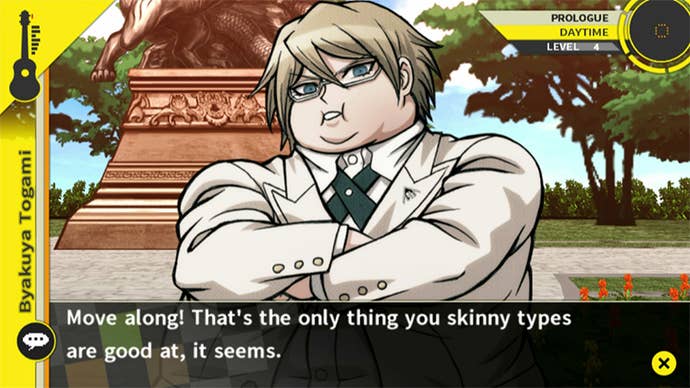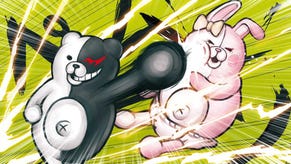Danganronpa 2: Goodbye Despair Vita Review: Last Resort
Don't let the anime aesthetic fool you—Spike Chunsoft's ambitious sequel contains some of the best writing you'll ever see in a video game.
This article first appeared on USgamer, a partner publication of VG247. Some content, such as this article, has been migrated to VG247 for posterity after USgamer's closure - but it has not been edited or further vetted by the VG247 team.
Some of the greatest gaming experiences I've had in recent years have sprung from visual novels—games that tell long, involved stories using relatively primitive means: still images, text, and maybe a little voice acting here and there. Phoenix Wright's DS debut grabbed me back in 2006, and since then, I've devoured any game from this genre with an English localization.
Seeing as my favorite visual novels tend to sprinkle in puzzles or other elements to break up the narrative, this winter's Danganronpa: Trigger Happy Havoc easily became my favorite of the bunch. It operated on a gripping, high-stakes premise with more twists and turns than a later season of Breaking Bad, and dropped 16 well-developed characters into a series of progressively convoluted murder mysteries, with enough devotion to this literary genre's rules to make Agatha Christie blush. Though Danganronpa communicates its plot through low-budget theatrics, it nonetheless put me through a harrowing and unforgettable experience I'm itching to relive just as soon as my brain forgets all the important details.

Danganronpa 2: Goodbye Despair understands what made the series' debut so popular (in Japan, anyway), and it doesn't tamper too much with the formula. As with the original game, Goodbye Despair traps 16 characters in an inescapable situation, and with only one way to get out: Kill, and be sure that you're not found guilty at the resulting Class Trial. If the murderer is found guilty, he or she is put to death, and life goes on—but if the wrong person is identified as the killer, the true culprit gets to leave, while everyone else receives an immediate death sentence. As with the first game, Danganronpa 2 offers a high-stakes atmosphere, where at least two characters will die in every chapter—and with absolutely no warning, at that.
Thankfully, as with the first game, Goodbye Despair's cast of compelling oddballs makes it easy to get invested in their plight. The 15 characters you immediately meet may seem to be nothing but explicit stereotypes, since they've been chosen as the "Ultimates" of their respective fields: gaming, animal breeding, cooking, team managing, and so on. But Danganronpa 2 comments on the lack of substance found in most anime-style stories, as each of these characters' stereotypes are gradually revealed to be facades constructed as a means of self-defense. As their personalities gradually unfold, you'll genuinely begin to root for some of these sympathetic weirdos—so don't be surprised their sudden deaths legitimately upset you.
Danganronpa 2 might operate on the first game's premise, but it offers some welcome improvements. The new tropical island setting provides a much more varied set of locations than the first DR's shuttered schoolhouse, and now, 3D navigation is limited to smaller areas, rather than the whole map. And, in the spirit of constantly breaking up the action, Goodbye Despair gives its protagonist a virtual pet that pays out if you attend to its upkeep, as well as an RPG-lite system that rewards players for hoofing it to locations (rather than teleporting) and exploring every last bit of text the game has to offer. Overall, Goodbye Despair does an excellent job of bouncing between different styles of play, so you won't grow bored by only absorbing its story. In the course of a chapter, you'll be investigating new sections of the island paradise, hanging out with characters in your free time, conducting investigations, and tracking down hidden Monokumas (the series' dastardly stuffed bear antagonist) for rewards.
Once again, Danganronpa 2's trial scenes are the main attraction, and they still resemble Phoenix Wright's courtroom antics injected with a crate of Red Bull. Goodbye Despair uses various weapon-based metaphors to simulate deductive reasoning, so instead of merely pointing out the contradiction in someone's testimony, you literally fire a bullet containing the contradiction at the offending text. These trial scenes—which often stretch out to two hours—mix in several mini-games to keep players engaged, even if the mechanics behind them don't amount to much more than choosing the right selection from a list. My favorite one, "Logical Dive," has the main character air-boarding through a Tron-style representation of his thoughts as he answers an escalating series of questions about an unresolved issue.

And Danganronpa 2's mysteries are astoundingly complex and well-written. Since the solutions depend on elaborate premises and the interconnected relationships between over a dozen characters, "whodunnit" takes a looong time to suss out. Going into every trial, I had absolutely no idea who to blame, and the identity of the killer always came as a surprise to me by the end. Though you're given some time to investigate the crime scene before being thrown into direct conflict with your island-bound companions, Danganronpa 2 has a way of deliberately leading you to the wrong conclusion, then doing an immediate about-face to show just how much this particular line of reasoning doesn't pan out. At no point did DR2's "gotcha" moments feel unearned—you can tell these mysteries come from the mind of someone with a deep love and respect for the genre, and success in this style of writing can only be found in keeping the reader's (or in this case, player's) trust.
It's a shame the Danganronpa series has been confined to the Vita just as Sony's abandoned it, since these seemingly straightforward visual novels contain some of the best writing—not to mention localization—I've seen in quite some time. And, while playing Danganronpa 2, as with the first game, I get a real sense of love from its creators that's all-too-absent these days. It's clear that Danganronpa's writer wants nothing more than to tell this type of story, which may explain why these games are so dense—in the kindest sense of the word, of course. I wouldn't go as far as to say this series merits the purchase of a Vita, but if you're looking for the finest example of visual novels to date, Danganronpa 2 continues the trend set by the first game and ups the stakes by being a bigger, better, and bolder adventure in mass murder.
VisualsDanganronpa 2 sticks to the same type of simple 2D images found in the last game, but there's a lot more variety this time around, and the island setting helps keep things from getting too claustrophobic.
SoundMasafumi Takada's soundtrack is equally strange and catchy, and lends much to the bizarre antics of Danganronpa 2. Also, the English voice acting is superb, even if you're a stickler for the original language track.
InterfaceThough the Vita's touch controls don't lend much to this PSP port, Danganronpa 2 dresses up its basic interface with UI flourishes that make its basic, text-based interface more interesting than it could have been.
Lasting AppealDanganronpa 2 offers a long and involved story, and a variety of modes to fool around with once you finish the main game. And you'll definitely want to come back to this weird cast of characters once you forget the details behind (most of) their deaths.
ConclusionWhile it doesn't have quite the impact as the series' debut, Danganronpa 2 continues the tradition of elaborate murder mysteries featuring appealing characters, and won't let you put it down until the bloody end. If you've been pondering the visual novel genre and don't know where to start, NIS America's answer to the courtroom antics of Phoenix Wright is an excellent place to start.




